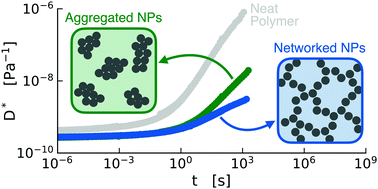Creep attenuation in glassy polymer nanocomposites with variable polymer–nanoparticle interactions†
Abstract
The use of nanoparticle reinforced polymer matrices in continuous fiber composites for infrastructure applications requires a comprehensive understanding of viscoelastic creep. Critical parameters affecting the mechanical reinforcement offered by nanoparticles include nanoparticle size and concentration, as well as the interaction between the nanoparticle surface and polymer matrix. Here, we study the viscoelastic creep of nanocomposite systems comprised of glassy thermoplastic polymers and spherical silica nanoparticles of varying sizes and surface functionalization using a dynamic mechanical analysis (DMA) accelerated testing methodology. Significant differences in the nanoparticle dispersions in these nanocomposites were observed via transmission electron microscopy (TEM) and small-angle X-ray scattering (SAXS) and are attributed to differences in the polymer–polymer and polymer–particle interaction strengths. The DMA measurements indicate a decrease in compliance at short times with increased nanoparticle loading that is largely independent of nanoparticle dispersion morphology and polymer–particle interaction strength. Conversely, long term creep behavior shows a much stronger dependence on these parameters with the creep onset time increasing by up to three orders of magnitude. For similar nanoparticle loadings, the time to critical deformation in systems with well-distributed, networked nanoparticle morphologies was larger by an order of magnitude compared to systems exhibiting strong nanoparticle aggregation. The networked systems delayed the time to critical deformation by three orders of magnitude over that of neat polymer. The increase in time to critical deformation is also greater in composites with smaller nanoparticles at similar loadings, which we attribute to the development of percolated nanoparticle networks. These results demonstrate the significant effects polymer–particle interactions and dispersion morphologies can have on the long-term creep compliance of thermoplastic nanocomposites.



 Please wait while we load your content...
Please wait while we load your content...